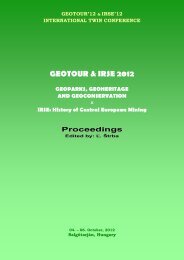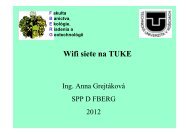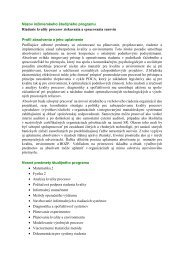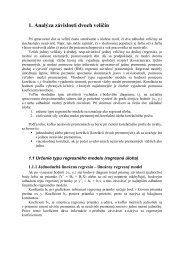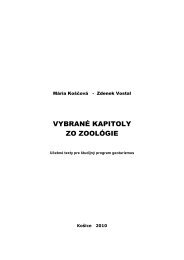GEOTOUR & IRSE 2012.pdf - Fakulta BERG - TUKE
GEOTOUR & IRSE 2012.pdf - Fakulta BERG - TUKE
GEOTOUR & IRSE 2012.pdf - Fakulta BERG - TUKE
You also want an ePaper? Increase the reach of your titles
YUMPU automatically turns print PDFs into web optimized ePapers that Google loves.
<strong>GEOTOUR</strong> & <strong>IRSE</strong> 2012<br />
Lencsés spring, Háromkúti spring, Szent Imre spring, etc.). Despite the enclosing, there is no<br />
water in a number of them all year round, but in the case of the most significant ones, the<br />
spring yields water all year long.<br />
Cold water springs used as water supply<br />
The largest springs of the Bükk have been in use to provide water supply for a long time. The<br />
largest spring of the Bükk Mountains became the water supplier of Miskolc in 1913. The<br />
spring, called Olasz well, had become the base of the water supply. Further springs ensuring<br />
the water supply of the city are Felső spring, Szinva fő spring, and the springs of the Anna<br />
sinter cave. The water supply of Felsőtárkány originates from the Szikla spring, and the water<br />
of the Jávorkút establishment comes from the Jávorkúti spring.<br />
Not enclosed tepid water springs<br />
The only such spring is located in Miskolctapolca, on the Szerelem island, and in the lake<br />
surrounding Szerelem island. The former has appeared only in recent years. The tepid springs<br />
yield into the lake around the Szerelem Island creating a lot of gas bubbles.<br />
Tepid and warm water springs used for bath and medicinal purposes<br />
There is evidence that the warm and tepid springs of the Bükk‟s brim have been used for<br />
bathing purposes ever since the Turkish times, but there are signs indicating that the water had<br />
been used previous to that as well. The springs of the large swimming pool of Eger, the<br />
Bárány pool and the Turkish Bathhouse must be mentioned, beside the Termál spring of<br />
Miskolctapolca, and the warm springs of Kács.<br />
Tepid water springs used as water supply<br />
Most of the time the tepid waters are mainly used as water supply, but the water of Szent<br />
György spring already had been used in the 13th century as bath water for Hungarian queens.<br />
The Tavi spring is connected to the water supply of Miskolc, along with the Termál spring,<br />
but this latter is also part of the water supplied to bathing purposes for the cave bath.<br />
Springs of ago<br />
There is a riolit tuff belt at the south brim of the Bükk. The belt stretches from NE to SW, and<br />
it significantly blocks subsurface karst water movement towards south. Upwelling springs,<br />
containing silicium dioxide, have entered the riolite tuff, making it even harder. Later surface<br />
erosion partly cleared away the riolit tuff layer but the shafts used by the one-time upwelling<br />
water were covered with silex, and this layer remained behind. Such formations are called<br />
beehive rocks, and the most significant ones can be found at Szomolya, Cserépfalu, and<br />
Cserépváralja, but there are others in other locations as well.<br />
Creeks<br />
There are about a couple of dozens of creeks of various yields exit the Bükk Mountains. Most<br />
of them are permanently active, although their yields can be greatly fluctuating. These are<br />
mostly fed by karst springs. They have high direct and indirect natural value, and they are<br />
important elements of the landscape.<br />
Waterfalls on the creeks (sinter)<br />
A significant amount of Bükk creeks have waterfalls on them in various sizes. Most of these<br />
are formed on sinter „stairs‟. The most important ones are the Szinva waterfall, the Fátyol<br />
waterfall on the Szalajka creek, and the Alsó Sebes waterfall, etc.<br />
77



